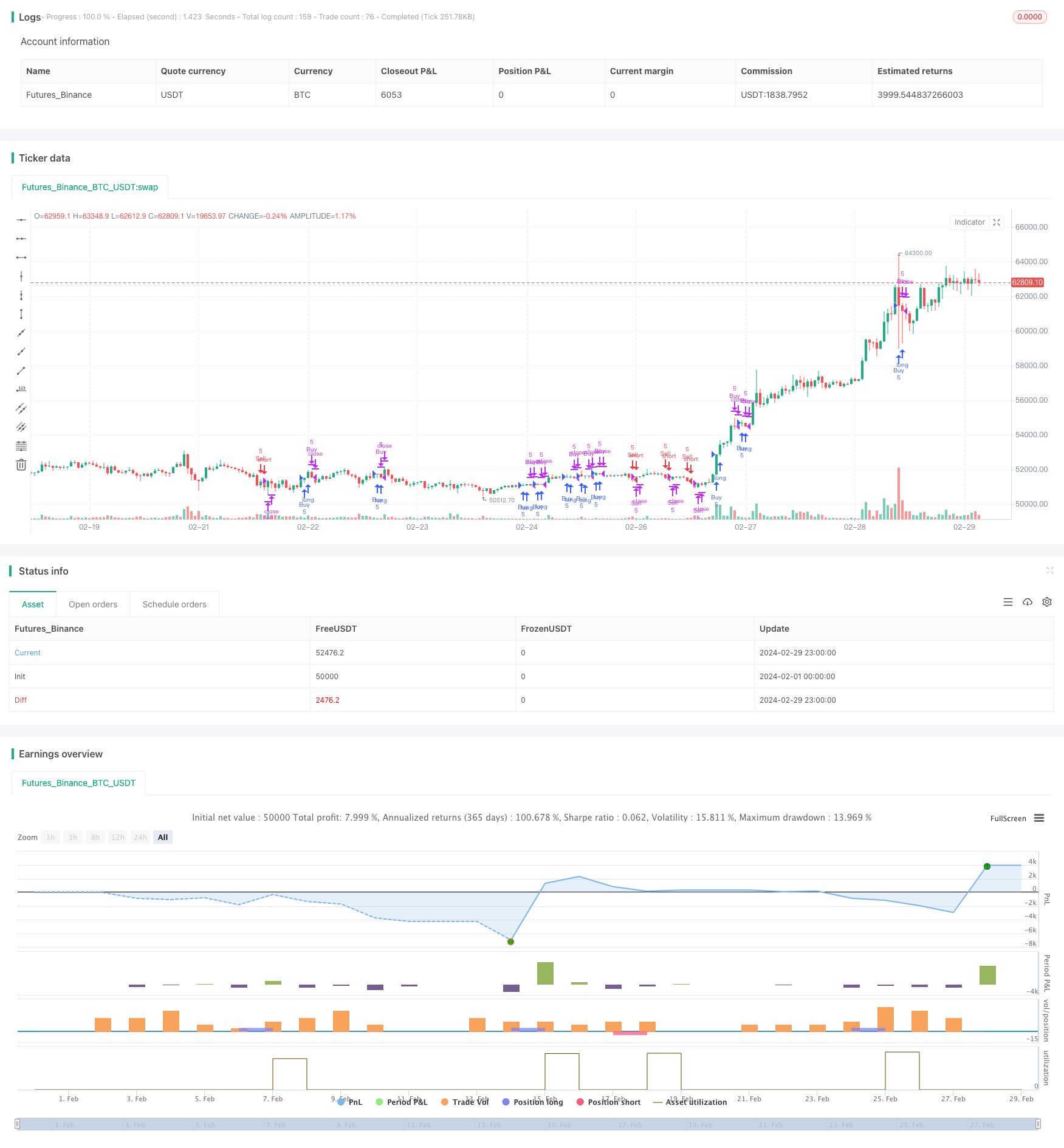
概述
这个基于Pine Script编写的策略旨在通过1-2-3形态,结合指数移动平均线(EMA)和移动平均线收敛散度(MACD)指标的附加条件,来识别潜在的买卖信号。该策略利用了价格形态、趋势确认和动量指标,以提供全面的交易信号。
策略原理
该策略的核心是识别1-2-3形态,这是一种常见的价格形态,由三根连续的蜡烛线组成,表明潜在的趋势反转。对于买入信号,第一根蜡烛线收盘价高于开盘价,第二根蜡烛线收盘价低于开盘价,第三根蜡烛线收盘价高于第一根蜡烛线的收盘价,最后第四根蜡烛线的收盘价高于第三根蜡烛线的收盘价。卖出信号的条件正好相反。
除了1-2-3形态,该策略还采用了EMA和MACD指标来确认趋势方向和潜在的趋势反转。9期EMA和20期EMA用于趋势确认,而MACD线和信号线则用于识别动量和潜在的趋势反转。
当满足所有买入条件时,即1-2-3形态形成、收盘价高于两条EMA、MACD线高于信号线,策略会开立多头仓位。类似地,当满足所有卖出条件时,策略会开立空头仓位。当产生相反信号或当前蜡烛线收盘方向与持仓方向相反时,策略会平掉相应仓位。
优势分析
- 结合价格形态、趋势确认和动量指标,提供全面的交易信号。
- 1-2-3形态是一种常见且可靠的价格形态,能够有效捕捉潜在的趋势反转。
- 使用EMA和MACD指标进一步确认趋势方向和动量,提高信号的可靠性。
- 明确的进场和出场规则,易于理解和实施。
风险分析
- 该策略仅基于单一时间框架,可能错过其他时间框架的重要信息。
- 在震荡市场或趋势不明确时,该策略可能产生错误信号。
- 未考虑风险管理,如止损和仓位调整,这可能导致重大损失。
- 策略的参数未经过优化,可能不适用于所有市场条件。
优化方向
- 引入多时间框架分析,确认不同时间尺度上的趋势一致性。
- 加入风险管理措施,如基于ATR的动态止损和仓位调整。
- 对策略参数进行优化,如EMA和MACD的周期设置,以适应不同的市场状况。
- 考虑加入其他技术指标或市场情绪指标,以提高信号的可靠性。
总结
这个基于1-2-3形态、EMA和MACD指标的策略提供了一种全面的方法来识别潜在的买卖信号。它结合了价格形态、趋势确认和动量指标,以生成可靠的交易信号。然而,该策略也存在一些局限性,如缺乏风险管理措施和参数优化。通过引入多时间框架分析、动态止损和仓位调整,以及参数优化,可以进一步提高策略的性能。此外,加入其他技术指标或市场情绪指标也有助于提高信号的可靠性。尽管如此,在实际交易中应用该策略之前,仍需要对其进行全面的回测和验证。总的来说,这个策略为交易者提供了一个良好的起点,通过进一步的优化和改进,有望成为一个稳健和盈利的交易策略。
策略源码
/*backtest
start: 2024-02-01 00:00:00
end: 2024-02-29 23:59:59
period: 1h
basePeriod: 15m
exchanges: [{"eid":"Futures_Binance","currency":"BTC_USDT"}]
*/
//@version=5
strategy("1-2-3 Pattern Strategy with EMAs, MACD, and 4th Candle Extension", overlay=true)
// Define conditions for the 1-2-3 pattern for buy orders
buy_candle1_above_open = close[3] > open[3]
buy_candle2_below_open = close[2] < open[2]
buy_candle3_above_close = close[1] > close[3]
buy_candle4_above_close = close > close[3]
// Define conditions for the 1-2-3 pattern for sell orders
sell_candle1_below_open = close[3] < open[3]
sell_candle2_above_open = close[2] > open[2]
sell_candle3_below_close = close[1] < close[3]
sell_candle4_below_close = close < close[3]
// Fetch 9 EMA, 20 EMA, and MACD
ema_9 = ta.ema(close, 9)
ema_20 = ta.ema(close, 20)
[macd_line, signal_line, _] = ta.macd(close, 12, 26, 9)
// Implement strategy logic for buy orders
if (buy_candle1_above_open and buy_candle2_below_open and buy_candle3_above_close and buy_candle4_above_close and strategy.opentrades == 0 and close > ema_9 and close > ema_20 and macd_line > signal_line)
strategy.entry("Buy", strategy.long, qty=5)
if (close < open and strategy.opentrades > 0)
strategy.close("Buy", qty=5)
// Implement strategy logic for sell orders
if (sell_candle1_below_open and sell_candle2_above_open and sell_candle3_below_close and sell_candle4_below_close and strategy.opentrades == 0 and close < ema_9 and close < ema_20 and macd_line < signal_line)
strategy.entry("Sell", strategy.short, qty=5)
if (close > open and strategy.opentrades > 0)
strategy.close("Sell", qty=5)